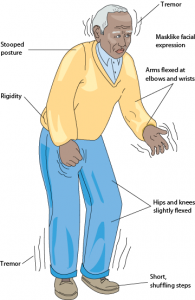Parkinson’s Disease; an Introduction
This is a post for World Parkinson’s Day to raise awareness of the condition. There’s quite a bit to get through, so please feel free to select the parts most relevant to you.
What is Parkinson’s Disease?
Parkinson’s disease is a deterioration of areas of the brain called the basal ganglia, which are responsible for controlling movement. Around 0.3% of people in the industrialized world will develop the condition. It is most common in the over 50s, with around 4-5% of over-85s developing Parkinson’s. With an aging population, Parkinson’s is likely to become more common in the future. People can also develop Parkinson’s-like symptoms (known as ‘Parkinsonism’), but the distinguishing feature of Parkinson’s itself is the degeneration of the nerve cells which make and respond to the chemical dopamine. Of course, we can’t see this degeneration without sophisticated scanning equipment, so for us lay folk, it’s much more useful to look at the physical symptoms we might see in ourselves and others.
What are the symptoms of Parkinson’s?
There are 3 main symptoms associated with early Parkinson’s disease:

Symptoms of Parkinson’s Disease. Not every patient will have all these symptoms.
-
Tremor – a trembling in parts of the body such as hands, feet, face, lips and tongue. These tremors usually start in one limb when it is supported and at rest, and stop with movement and sleep. Gradually they spread throughout the body.
-
Rigidity, or stiffness – jerky movements that take a lot of energy to perform. Again, this generally starts on one side of the body, and progresses to both sides.
-
Slowness in initiating and performing movement – or suddenly stopping in the middle of a voluntary movement. People often have difficulty in starting walking, or in turning. They may freeze while walking, or may lean forward and take small, shuffling steps when they walk.
If someone you know is in the over 50s age group, and is showing some or all of these symptoms, it’s important to get medical advice.
How is Parkinson’s Treated?
Parkinson’s disease can’t yet be cured or put in remission, but drug therapies can help manage the symptoms. The aim is to increase the amount of dopamine in the brain, and support the parts of the brain where dopamine has an effect. Patients can also be referred by their doctor to other services, such as physiotherapy, which can help them manage their symptoms.
How can Nutrition help?
Nutrition can’t improve the disease itself, but it can help with some of the symptoms, enable the drugs to be as effective as possible and support overall wellbeing. Ways in which the nutritional therapist can help include:
-
Identifying whether the patient may lack specific nutrients, and helping to include these in the diet.
-
Helping the patient to understand when to take medication in relation to meals or nutrients, and whether there are foods that can’t be eaten if the patient is using particular medications.
-
Identifying the way of eating that’s best for the patient, and providing suggestions to help

Eating well, and timing food and medication correctly, may help people with Parkinson’s.
them eat meals that work best for them.
-
Support general digestive health and energy production. In particular, recommend Parkinson’s-friendly protocols for indigestion and constipation.
-
Signpost other services that may be useful to support the patient’s well-being, depending on their needs.
For more information about nutrition and medicines, try ‘Parkinson’s Disease – Reducing Symptoms with Nutrition and Drugs’ by Geoffrey and Lucille Leader. Lucille is the leading nutritional therapist in this field, and works closely with doctors in a leading London hospital.
What else can help?
It’s very important that people with Parkinson’s see a speech therapist early on, to get help with speaking before their speech deteriorates too far. They should also be referred to a physiotherapist.
Appropriate exercise can also be very important in helping to maintain control of movement. Some people find that the right kind of exercise can slow down the rate at which their symptoms develop. My friend Jane Cullen specialises in exercise for people with Parkinson’s. You can find her at http://www.janemcullen.com/.
Many people with Parkinson’s find complementary therapies to be helpful. Although there is limited clinical evidence that these therapies work, a lot of people, both those with Parkinson’s, and those that care for them, find that they make a positive difference to their overall well-being. Since stress can exacerbate symptoms, therapies which reduce stress may be helpful. Therapies that have been useful include:
-

Some people find therapies which support relaxation helpful
Movement or touch-based therapies such as Alexander technique, Reiki and osteopathy.
-
Activity-based therapies such as music or art therapy.
-
Relaxation therapies such as meditation or aromatherapy.
There are even people who claim to have stopped the disease in its tracks by retraining their mind to use different pathways to compensate for the ones that have been lost. Of course, this is very controversial. If you’d like to know more about it, I’d recommend the book “The Brain’s Way of Healing: Stories of Remarkable Recoveries and Discoveries” by Norman Doidge.
Finding out More
If you’re concerned about Parkinson’s or care for someone who may have the condition, it’s important to visit your doctor as soon as possible. You can also visit www.parkinsons.org.uk, which is packed with advice and information. To get insight about the highs and lows of life with Parkinson’s, try my friend Jane Cullen’s novel ‘Say that Again’. It’s received acclaim around the world, particularly from people with Parkinson’s, who say that the portrayal of the lead character is incredibly accurate. Jane doesn’t have Parkinson’s, but she’s spent years helping people who do, so she knows her stuff.
If any of the issues in this post concern you, and you’d like to talk to me about them, please feel free to contact me.



